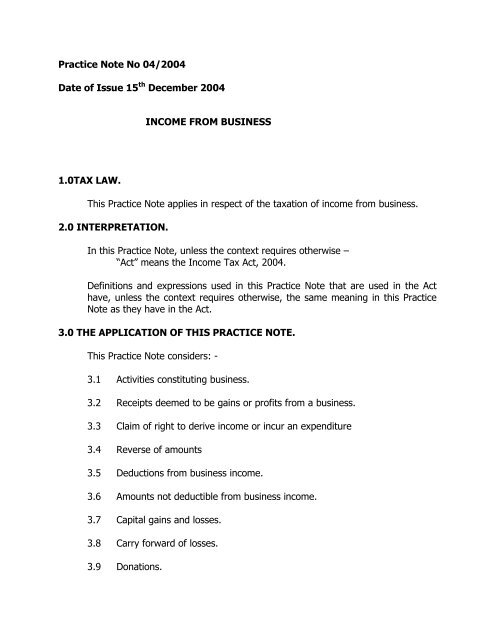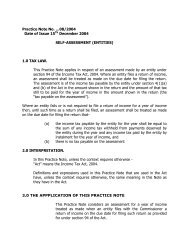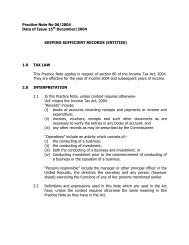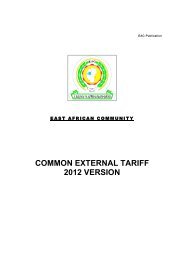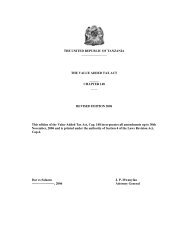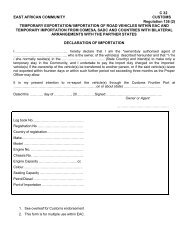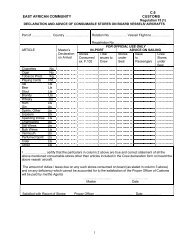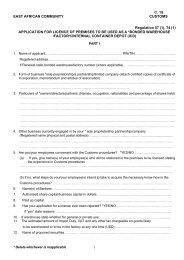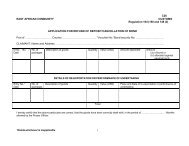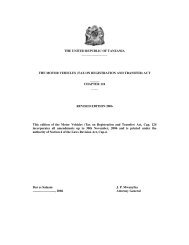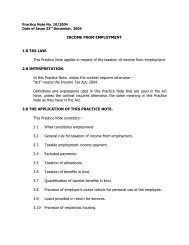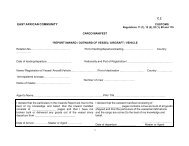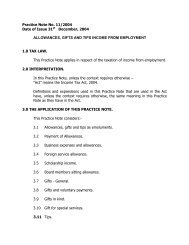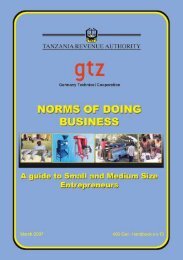Practice Note No 04/2004 Date of Issue 15th December 2004 ... - TRA
Practice Note No 04/2004 Date of Issue 15th December 2004 ... - TRA
Practice Note No 04/2004 Date of Issue 15th December 2004 ... - TRA
- No tags were found...
Create successful ePaper yourself
Turn your PDF publications into a flip-book with our unique Google optimized e-Paper software.
<strong>Practice</strong> <strong><strong>No</strong>te</strong> <strong>No</strong> <strong>04</strong>/20<strong>04</strong><strong>Date</strong> <strong>of</strong> <strong>Issue</strong> 15 th <strong>December</strong> 20<strong>04</strong>INCOME FROM BUSINESS1.0TAX LAW.This <strong>Practice</strong> <strong><strong>No</strong>te</strong> applies in respect <strong>of</strong> the taxation <strong>of</strong> income from business.2.0 INTERPRETATION.In this <strong>Practice</strong> <strong><strong>No</strong>te</strong>, unless the context requires otherwise –“Act” means the Income Tax Act, 20<strong>04</strong>.Definitions and expressions used in this <strong>Practice</strong> <strong><strong>No</strong>te</strong> that are used in the Acthave, unless the context requires otherwise, the same meaning in this <strong>Practice</strong><strong><strong>No</strong>te</strong> as they have in the Act.3.0 THE APPLICATION OF THIS PRACTICE NOTE.This <strong>Practice</strong> <strong><strong>No</strong>te</strong> considers: -3.1 Activities constituting business.3.2 Receipts deemed to be gains or pr<strong>of</strong>its from a business.3.3 Claim <strong>of</strong> right to derive income or incur an expenditure3.4 Reverse <strong>of</strong> amounts3.5 Deductions from business income.3.6 Amounts not deductible from business income.3.7 Capital gains and losses.3.8 Carry forward <strong>of</strong> losses.3.9 Donations.
0.0 HOW THE LAW APPLIES.0.1 Activities constituting conducting a business.“Business” includes a trade, concern in the nature <strong>of</strong> trade, manufacture,pr<strong>of</strong>ession, vocation or isolated arrangement with a business character;and a past, present or prospective business, but excludes employmentand any activity that having its nature and the principal occupation <strong>of</strong> itsowners or underlying owners, is not carried on with a view to derivingpr<strong>of</strong>its.Income from business is calculated as follows:-Amounts derived from conducting the businessDeduct any payments which have been subjected to a finalwithholding tax.Deduct depreciation allowanceDeduct or Add depreciation balancing adjustmentsDeduct trading stock allowanceAdd net capital gains (after deducting capital losses)Deduct any loss carry forward from previous yearDeduct donations.0.2 Receipts deemed to be gains or pr<strong>of</strong>its from a businessAmount treated as gains or pr<strong>of</strong>its from a business is the total amountcoming into the business for sale <strong>of</strong> goods and services (including sale <strong>of</strong>trading stock) and any other amount derived in doing business.In calculating the pr<strong>of</strong>its from any business the following amounts areincluded –(a)(b)(c)(d)(e)(f)Service fees.Incoming for trading stock.Gains from realisation <strong>of</strong> business assets or liabilities.Excess amounts derived in realisation <strong>of</strong> depreciable assets.Amounts derived as consideration for accepting a restruction on thecapacity to conduct the business.Gifts and ex gratia payments received by the person in respect <strong>of</strong>the business.
(g)Amounts derived that are effectively connected with the businessthat would otherwise be included in calculating the person’s incomefrom investment.The following receipts are excluded from calculating business income –(a) exempt amounts and final withholding payments.(b) amounts that are included in calculating the person’s income fromany employment.0.3 Claim <strong>of</strong> right to derive income or incur an expenditureFor the purposes <strong>of</strong> accounting for income tax purposes an amount shallbe treated as derived or expenditure incurred by a person notwithstandingthat the person is not legally entitled to receive the amount or liable tomake the payment. So long as the person claims to be legally entitled toreceive or legally obliged to pay the amount.0.4 Reverse <strong>of</strong> amountsWhere a person has deducted expenditure in calculating the person’sincome and the person later recovers the expenditure, the person shall, atthe time <strong>of</strong> recovery, include the amount recovered in calculating theperson’s income. Such reversals include:-Where a person has included an amount in calculating the person’sincome but because <strong>of</strong> the legal obligation to do so, the person laterrefunds the amount, the person may deduct the amount at the time <strong>of</strong>refund.Where in calculating income on accrual basis a person deductsexpenditure that the person shall be obliged to make and the personlater disclaims an obligation to incur the expenditure the person shall,at the time <strong>of</strong> disclaimer, include the amount disclaimed in calculatingthe person’s income.Where in calculating income on an accrual basis a person includes anamount to which the person is entitled and the person later disclaimsan entitlement to receive the amount or in the case <strong>of</strong> a bad debtclaim <strong>of</strong> the person, the person writes <strong>of</strong>f the debt as bad the personmay, at the time <strong>of</strong> disclaimer or write <strong>of</strong>f, deduct the amount.0.5 Deductions from business income.
(a)Business expenditure is deductable only when any business iscarried on by the person at any time during the year <strong>of</strong> income.(b)For the purposes <strong>of</strong> calculating a person’s income from business forany year <strong>of</strong> income no deduction shall be allowed for –i) consumption expenditureii) excluded expenditureiii) expenditure incurred by the person in deriving exemptamounts or final withholding paymentsiv) distributions by an entity.(c)For the purposes <strong>of</strong> calculating a person’s income for a year <strong>of</strong>income from a business, there shall be deducted all expenditureincurred during the year <strong>of</strong> income by the person, wholly andexclusively in the production <strong>of</strong> the income.For calculating the income from business, the following deductionsare allowable –i) Interest expense. Interest incurred by a person during a year <strong>of</strong> incomeunder a debt obligation shall be treated as incurred whollyand exclusively in the production <strong>of</strong> income from abusiness if the debt obligation was incurred in borrowingmoney employed in the business or to acquire an assetthat is employed during the year <strong>of</strong> income in theproduction <strong>of</strong> the income. In any other case, the debtobligation was incurred wholly and exclusively in theproduction <strong>of</strong> the business income.The total amount <strong>of</strong> interest that an exempt controlledresident entity may deduct for a year <strong>of</strong> income shall notexceed the sum <strong>of</strong> all interest derived by the entity duringthe year <strong>of</strong> income that is to be included in the entity’stotal income and 70 percent <strong>of</strong> the entity’s total income forthe year calculated without including any interest derivedor deducting any interest incurred by the entity.
Example 1An exempt-controlled resident company, M Ltd received during year 20<strong>04</strong>business income <strong>of</strong> Tshs. 6,000,000 including interest <strong>of</strong> Tshs. 4,000,000.During the year it incurred interest expenditure <strong>of</strong> Tshs. 5,000,000. Theallowable interest expenditure for the year 20<strong>04</strong> is calculated as follows:-Total business income for the year <strong>of</strong> income shs. 6,000,000Less interest derived amount (4,000,000) “and interest incurred 5,000,000 “ 1,000,000Balance shs. 7,000,00070% <strong>of</strong> the balance shs. 4,900,000Add:Interest received 4,000,000Maximum allowable expense shs. 8,900,000Since the maximum allowable interest expense is sh. 8,900,000/= thewhole interest expenditure amount <strong>of</strong> shs. 5,000,000 can be allowed as adeduction in the year 20<strong>04</strong>.
Example 2An exempt controlled company K Ltd made during the year business pr<strong>of</strong>it <strong>of</strong> shs.4,000,000 after deducting interest payment <strong>of</strong> shs. 3,500,000 and inclusive <strong>of</strong> interestreceipt <strong>of</strong> shs. 1,000,000. Ltd’s maximum allowable interest expense is calculated asfollows:-Taxable income/(loss) shs. 4,000,000Less Interest earned (1,000,000)Interest incurred 3,500,000 shs. 2,500,000shs. 1,500,00070% <strong>of</strong> the rest <strong>of</strong> the income shs. 1,050,000Maximum allowable interest expense is calculated as follows:Interest derived during the year shs. 1,000,00070 percent <strong>of</strong> company's other income shs. 1,050,000Maximum allowable interest expense shs. 2,050,000K Ltd’s income is adjusted as follows:Income declared shs. 4,000,000Add interest incurred shs. 3,500,000shs. 7,500,000Less maximum interest expense shs. 2,050,000Adjusted income for the year shs. 5,450,000Interest carry forward to following yearTotal interest incurred shs. 3,500,000Less expensed during the year shs. 2,050,000Carry forward interest shs. 1,450,000The interest amount <strong>of</strong> shs. 1,450,000 denied deduction during the year may be carriedforward and treated as incurred during the next year <strong>of</strong> income.ii) Trading Stock Allowance.For calculating a person’s business income for a year <strong>of</strong> income there shallbe deducted trading stock allowance. The allowance is calculated as:The opening value <strong>of</strong> trading stock <strong>of</strong> the business for the year <strong>of</strong> incomeAdd expenditure incurred by the person during the year that is enacted inthe cost <strong>of</strong> the trading stock.
Deduct the closing value <strong>of</strong> the trading stock <strong>of</strong> the business forthe year <strong>of</strong> income.The closing value <strong>of</strong> trading stock <strong>of</strong> a business for a year <strong>of</strong> income shallbe the lower <strong>of</strong> the cost <strong>of</strong> the trading stock <strong>of</strong> the business at the end <strong>of</strong>the year <strong>of</strong> income OR the market value <strong>of</strong> the trading stock <strong>of</strong> thebusiness at the end <strong>of</strong> the year. When the closing value <strong>of</strong> the tradingstock is determined on the basis <strong>of</strong> the market value the cost <strong>of</strong> thetrading stock shall be reset to that value.ExampleThe trading stock position <strong>of</strong> company J Ltd as at the end <strong>of</strong> the year <strong>of</strong>income is shown in the Trading Account as follows:Opening Stock shs. 15,000,000Purchases and cost’s “ 60,000,000shs. 75,000,000Closing stock “ 30,000,000Cost <strong>of</strong> sales shs. 45,000,000However, at the end <strong>of</strong> the year the market value <strong>of</strong> the stock isdetermined to be shs. 22,000,000.J Ltd’s trading stock allowance is determined as follows:Original trading stock allowanceOpening stock shs. 15,000,000Add Purchases and cost “ 60,000,000shs. 75,000,000Less Closing stock shs. 30,000,000Trading stock allowance shs. 45,000,000Revised trading stock allowanceSince the closing stock value is adjusted at market value the adjustedstock allowance is reset as:Opening stock value shs. 15,000,000Add Purchases and cost “ 60,000,000shs. 75,000,000Less revalued closing stock shs. 22,000,000
Adjusted Trading Stock allowance shs. 53,000,000The trading stock allowance for the year <strong>of</strong> income is taken as shs.53,000,000 and not shs. 45,000,000. <strong><strong>No</strong>te</strong> that the opening stock valuefor the next year <strong>of</strong> income will now be shs. 22,000,000 and not shs.30,000,000.iii) Repair and Maintenance expenditure.For the purposes <strong>of</strong> calculating a person’s income for a year <strong>of</strong> income from anybusiness, these shall be calculated all expenditure to the extent incurred deriving the year<strong>of</strong> income by the person and in respect <strong>of</strong> the repair and maintenance <strong>of</strong> depreciableassets owned and employed by the person wholly and exclusively in the production <strong>of</strong>the person’s income from the business. <strong><strong>No</strong>te</strong> that no deduction shall be allowed forexpenditure in improving an asset, which may be included in the cost <strong>of</strong> the asset andallowed either in calculating gains or losses on realisation or depreciation allowances.iv) Agriculture, research, development andenvironmental expenditures.For the purposes <strong>of</strong> calculating a person’s income from business for anyyear <strong>of</strong> income expenditure on agricultural improvement, research anddevelopment and environmental expenditure to the extent incurred whollyand exclusively in the production <strong>of</strong> the income from the business shall beallowed.Agricultural improvement expenditureFor the purposes <strong>of</strong> the deduction “agricultural improvement expenditure”means expenditure incurred by the owner or occupier <strong>of</strong> farm land inconducting agriculture, livestock farming or fish farming business wherethe expenditure is incurred on clearing the land and excavating irrigationchannels or planting perennial crops or trees bearing crops.Environmental expenditure“Environmental expenditure” means expenditure incurred by the owner <strong>of</strong>farmland for the privention <strong>of</strong> soil erosion or in connection with newdyingany damage caused by natural resource extraction operations to thesurface <strong>of</strong> or environment on land. Where in conducting a resourceextraction business a person makes a provision for any expenditure inconnection with remedying any damage caused by the resource extractionthe Commissioner may, in writing, subject to such terms and conditions asthe Commissioner thinks and for the purpose <strong>of</strong> the deduction only, treatthe provision as environmental expenditure incurred in conducting thebusiness.
Research and development expenditure“Research and development expenditure” means expenditure incurred inthe process <strong>of</strong> developing the person’s business and improving businessproducts or process and includes expenditure incurred by a company forthe purposes <strong>of</strong> an initial public <strong>of</strong>fer and first listing on the Dar es SalaamStock Exchange. However, the expenditure excludes any expenditureincurred that is otherwise included in the cost <strong>of</strong> any asset used in anysuch process, including an asset consisting expenditure incurred by aperson in the person’s business in respect <strong>of</strong> natural resource prospecting,exploration and development.Terms and conditions for Commissioner’s approval <strong>of</strong> a provision forenvironmental expenditureIn approving a provision for environmental expenditure to be allowed as adeduction incurred a person the Commissioner shall specify a date bywhich the expenditure must be incurred by the person, which date shallnot be more than two years after the date by which resource extractionhas substantially ceased.Where the Commissioner approves the provision and the person does notincur the expenditure by the specified time the Commissioner shall adjustany assessment <strong>of</strong> the person so as to remove the deduction, whichadjustment will be made irrespective <strong>of</strong> the time limit for making anassessment. The person shall be liable for interest for under estimatingthe tax payable by instalment and interest for failure to pay tax. Theperson shall also be liable for penalty for making false or misleadingstatement calculated as though the person made, without reasonableexcuse, a statement to the Commissioner in claiming the deduction thatwas false or misleading in a material particular.v) Gifts to public and charitable institutions.For the purposes <strong>of</strong> calculating income from a business amountscontributed during the year <strong>of</strong> income to a charitable institution or socialdevelopment project or deduction made under section 12 <strong>of</strong> the EducationFund Act, 2001 shall be deducted. The available deduction in respect <strong>of</strong> adeduction other than a donation made under the Education Fund Act,2001, shall be capped at 2 percent <strong>of</strong> the person’s income from businesscalculated without the deduction.vi) Depreciation Allowances for Depreciable Assets.Depreciation Allowances are allowed in respect <strong>of</strong> depreciable assets. Adepreciable asset is an asset employed wholly and exclusively in theproduction <strong>of</strong> income <strong>of</strong> a business, which was or benefit to the businesslasting more than one year, and which is likely to lose value because <strong>of</strong>
wear and tear, obsolescence or the passing <strong>of</strong> time. Land, shares andtrading stock are excluded. Depreciable assets include machinery,vehicles, equipment, buildings, frameworks and legal rights which expire(leases, franchise). When a person purchases and starts using adepreciable asset, or makes an improvement to a depreciable asset, theperson cannot deduct the full amount <strong>of</strong> the expenditure in the first year,except for agriculture and mining business assets, but can deduct portions<strong>of</strong> the expenditure for a number <strong>of</strong> years until the full expenditure hasbeen deducted. The deduction system can be straight line method orreducing balance method. The conditions for entitlement <strong>of</strong> depreciationallowances deduction are that the asset should be owned by the personand the asset should actually be used wholly and exclusively in theproduction <strong>of</strong> the income.vii) Losses on realisation <strong>of</strong> business assets andliabilities.In calculating a person’s income for any year <strong>of</strong> income from any businessfrom the following realisations shall be allowed –Business asset <strong>of</strong> the business that was employed wholly andexclusively in the production <strong>of</strong> the income from the business;a debt obligation incurred in borrowing money which was employed oran asset purchased with the money is or was employed wholly andexclusively in the production <strong>of</strong> the income; ora liability <strong>of</strong> the business other than a debt obligation incurred isborrowing money, where the liability was incurred wholly andexclusively in the production <strong>of</strong> the income from the business.viii) Losses from a business.For calculating the income <strong>of</strong> a person from business other than theincome <strong>of</strong> a partnership or a foreign permanent establishment, anyunrelieved loss <strong>of</strong> the year <strong>of</strong> income <strong>of</strong> the person from any otherbusiness and any unrelieved loss <strong>of</strong> a previous year <strong>of</strong> income <strong>of</strong> theperson from business shall be deducted.Foreign source losses shall be deducted only in calculating the person’sforeign source income.Where a person calculates income for a year <strong>of</strong> income from more thanone business <strong>of</strong> the person and deducts an unrelieved loss in more thanone such calculation, the person may choose the calculation orcalculations in which the loss or part <strong>of</strong> the loss is deducted.
ix) Capital losses.Capital losses are calculated for other “business assets”. Other “businessassets” are assets which are used as part <strong>of</strong> a person’s business but arenot trading stock and they are not depreciable assets. The followingassets are excluded from business assets and are therefore not liable forinclusion in capital loss calculations:-If a trading individual, an interest in land that has a market value <strong>of</strong>less than shillings 10 million at the time it is sold and that has beenused for agricultural purposes for at least two <strong>of</strong> the three years priorto sale.In case <strong>of</strong> a resident corporation, shares in another residentcorporation in which the first resident corporation holds more than 25percent <strong>of</strong> the shares.Shares and securities listed on the Dar es Salaam Stock Exchange.Capital losses may be made when a person realises (sells) an asset. Whena person makes a capital loss from the sale <strong>of</strong> other business assets theperson may deduct the loss from the person’s income from business.x) Carry forward losses.If a person made a loss from the person’s business in the previous year,the loss can be carried forward and deducted from the current year’sbusiness income. Losses can be carried forward this year from year toyear indefinitely. However loss carry forward is subject to the followinglimitations:-(a)(b)(c)Limits on losses <strong>of</strong> corporationsIf a corporation is sold (at least 50% <strong>of</strong> the underlying ownershipchanges) than losses made by it before the sale cannot be used to<strong>of</strong>fset its income after the sale. The exception is where for a period<strong>of</strong> two years after the change the corporation conducts no businessother than that conducted at any time during the twelve monthperiod before the change.Limits on capital lossesIf a corporation makes a loss when selling a business asset, it can<strong>of</strong>fset only gains from selling other business assets.Foreign losses
Foreign business losses can <strong>of</strong>fset only foreign business income,losses on the sale <strong>of</strong> foreign business assets can <strong>of</strong>fset only gainson sale <strong>of</strong> foreign business assets.Example.A corporation C Ltd made during the year <strong>of</strong> income 01 investment loss <strong>of</strong>sh. 1,200,000 and business loss <strong>of</strong> Tsh. 2,800,000. During the year 02 thecorporation made Investment gain <strong>of</strong> shs. 4,200,000 and business pr<strong>of</strong>its<strong>of</strong> sh. 2,000,000. The corporation’s taxable income from business andinvestment in year 02 will be calculated as follows:-Investment incomeInvestment gain shs. 4,200,000Less Loss carry forward from year 01 “ 1,200,000Net gain shs. 3,000,000Business incomePr<strong>of</strong>it from business shs. 2,000,000Business loss carried forward “ (2,800,000)Net business loss carry forward to year 03 shs. (800,000)xi)Bad debtDeduction is allowed for the purposes <strong>of</strong> calculating income <strong>of</strong> a personfrom any business in respect <strong>of</strong> any debt or part there<strong>of</strong> which hasbecome bad or irrecoverable during the year <strong>of</strong> income subject to thefollowing conditions.In the case <strong>of</strong> a debt claim <strong>of</strong> a financial institution, only after theclaim has become bad debt as determined in accordance with therelevant standards established by the Bank <strong>of</strong> Tanzania.In any other case, only after the person has taken all reasonable stepsin pursuing payment and the person reasonably believes that the debtclaim will not be satisfied.The debt must have been included in calculating the person’s incomefor the year <strong>of</strong> income.The debt must have been written <strong>of</strong>f as irrecoverable in the books <strong>of</strong>accounts <strong>of</strong> the person for that year <strong>of</strong> income in which the debt isclaimed to have become bad.Taxable income <strong>of</strong> C Ltd for the year 02 is as follows:-Investment income shs. 3,000,000
Business loss “ 800,000C Ltd will pay tax on investment pr<strong>of</strong>its <strong>of</strong> shs. 3,000,000 and carryforward business loss <strong>of</strong> shs. 800,000 to year 03.


